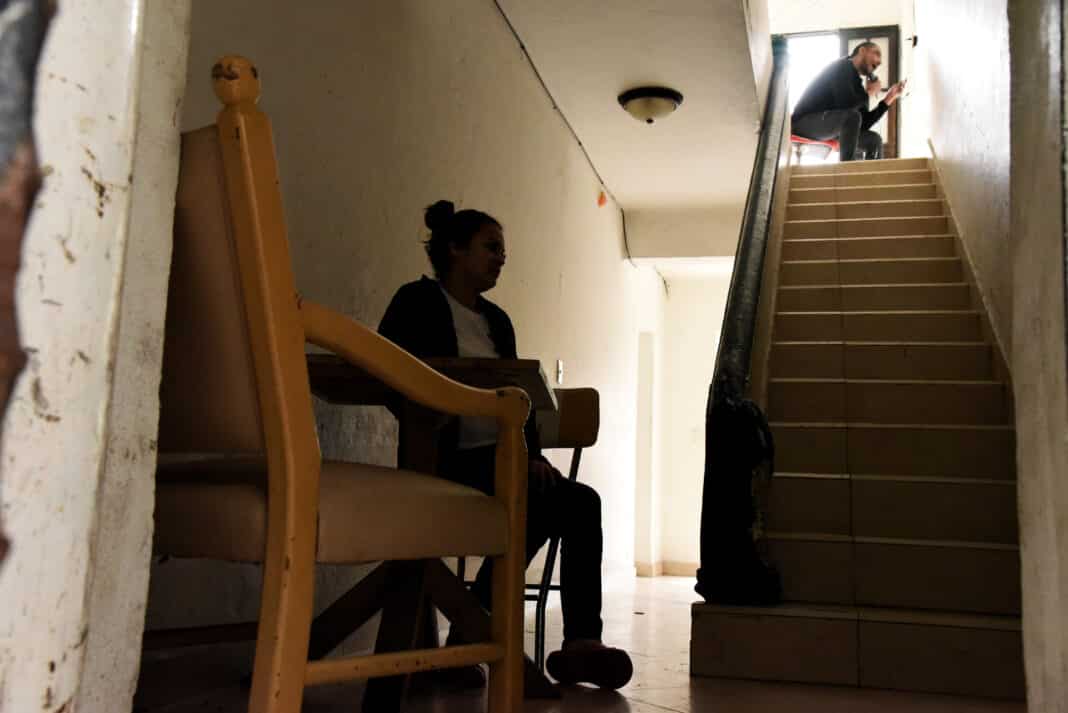As people in Brownsville headed to work Thursday morning, some slowed down as they passed the Xeriscape Park to read posters held by two people who stood there for the thousands who could not.

(Valerie Gonzalez | [email protected])
Felicia Rangel Samponaro and Victor Cavazos, co-directors of the Sidewalk School — an organization employing migrant asylum seekers with teaching degrees from their home countries to educate migrant children waiting in Mexico — were livestreaming their peaceful demonstration.
“They’re not being allowed to cross, even though asylum seekers are now being dropped off at the bus station here in Brownsville every day,” Rangel Samponaro said referring to the thousands subject to the Migrant Protection Protocols, or MPP.
The Trump era program forced migrants to Mexico while they waited for their U.S. immigration court hearings. It was implemented in the Rio Grande Valley about a year and half ago. Recent developments allowing migrant families that recently arrived at the border permission to wait for their immigration court hearings in the U.S. stirred greater desperation among those living in Matamoros under oppressive conditions.
“It’s not fair,” Melvin, a 22-year-old migrant from Guatemala said as he sat Friday morning on a plaza bench, the same place where he and his brother slept shortly after they were enrolled into MPP in July 2019. “They’re taking in the people who are coming in at the end of the line and are letting them cross.”
Many of the families recently released into the U.S. are seeking asylum, like Melvin. But, unlike him, they were never placed into MPP. President Joe Biden halted the program during his first day in office.

(Valerie Gonzalez | [email protected])
Those recently released in the Rio Grande Valley arrived at the border only a few days before they encountered the U.S. Border Patrol. Customs and Border Protection said pandemic space restrictions, limited U.S. holding capacities, and changes in Mexican law compelled the releases. Mexico’s Exterior Relations Office shared a statement that assured they are still accepting Central Americans returned from the United States through Title 42 expulsions which began after the pandemic. Though, “it’s also ordinary that there are adjustments at the local level, but that doesn’t mean that the practice changed or ceased,” the statement reads.
Back at the plaza in front of the Matamoros encampment, Melvin nervously wrung his hands and pulled at his blue bracelets the same color as the painting featured on his T-shirt while he searched his memory for the moment he nearly lost his life.
“After the first two bullets hit me, I felt the one here,” Melvin said pointing at his arm, “and this one,” he said touching the right side of his chest.”
He was shot six times in Guatemala. After that, he only remembers the two-month stay at the hospital and his father’s advice to leave with his older brother to the U.S. as soon as he could walk.
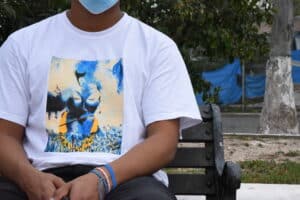
(Valerie Gonzalez | [email protected])
Instead, under MPP, Melvin and his brother were sent into Mexico without a plan on how to survive.
Eventually, Melvin’s artistic talent paired with the Sidewalk School’s ingenuity allowed the brothers to earn a living painting and teaching while they waited for their asylum hearings. The hearings ultimately resulted in a denial.
Samponaro said, referring to Melvin, “he was shot six times in the stomach and chest and was denied by a U.S. judge because he couldn’t prove he would get shot again.”
Many like Melvin turned to the appeals process hoping for a better outcome. His fellow teacher, Gaby, a 26-year-old single mother from Honduras is caring for her 5-year-old son in Matamoros after they were sent back under the protocols.
“What am I going to do in Mexico?” Gaby said Friday afternoon speaking from the hallway outside her three-room apartment she shares with her son, partner and another family of three in Matamoros. As neighbors pass by, she waves cheerfully and exchanges smiles while she sits on the mismatched chairs of a wobbly, unfinished wooden table by the corner.
Gaby recalls feeling hopeless after she realized enrollment into MPP meant she and her son would now live in Mexico.
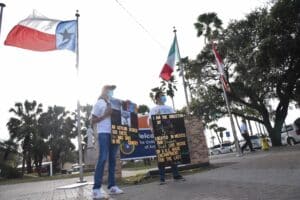
(Valerie Gonzalez | [email protected])
“I got here in Mexico without a peso, without a telephone, without clothing. I had five days without bathing, washing my teeth,” she said.
Kind strangers, a makeshift network between nonprofit organizations, and a work permit gave Gaby the ability to find work at a hair salon where she was allowed to take her child during the workday. Ultimately, her asylum case was denied. She’s pressing forward through the courts.
“Para atras no,” she said, there’s no going back.
Gaby is preparing herself and others for a future in the United States.
She prepared Friday afternoon for her now virtual class with children who attend the Sidewalk School. Gaby teaches conversational English including colors, titles of family members, and greetings.
“So that over there the kids are not anguished that they can’t talk or understand the teacher,” Gaby said. “At least they’ll be able to know what to say when they’re told, ‘Good morning,’ or ‘good afternoon,’ or ‘hello, how are you?’”
Since the presidential administration transition, Melvin said people are disheartened with the slow pace to address current MPP enrollees.
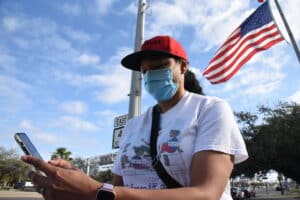
(Valerie Gonzalez | [email protected])
Attorneys attempted to remove a class of migrants who suffered through cartel kidnappings, gang rape, disappearances and witnessing floating bodies under the program days before Trump left office, but the litigious effort is still moving through the courts.
Frustration is building with the delayed efforts from the new administration to address those who remain living in limbo. Melvin heard rumors of people leaving the camp to attempt entry into the U.S.
Though Gaby entered the U.S. by wading through the river, she finds that option frightful. “What if I drown? Or my child drowns? If I die, or what if my child dies?”
On days when she feels the distance between her and the U.S. growing, Gaby heads to the riverbanks near Brownsville’s B&M Bridge where a border wall stands just a few feet away from the Mexican embankment.
“I feel like I have one foot here and one foot there,” she said as she stood near the Rio Grande. She says she still believes the new president could help shorten that distance.
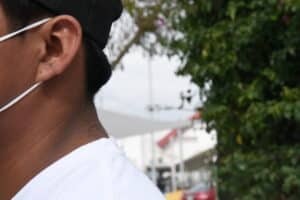
(Valerie Gonzalez | [email protected])
Migrants in the program like Melvin are hoping to receive priority consideration as immigration reform efforts continue. They believe the president can find a pathway to provide them a chance to enter the country legally.
“I wanted to do things right. Many of us wanted to do things right, do them legally,” Gaby said. “It would’ve been easy for us to go and live there undocumented. But no, I don’t want to be there illegally. I want to be there legally. I want my child to grow up well. I want my boy to have a good education without having to hide.”
Tan cerca y tan lejos, she said releasing a sigh and walking back to her apartment.

